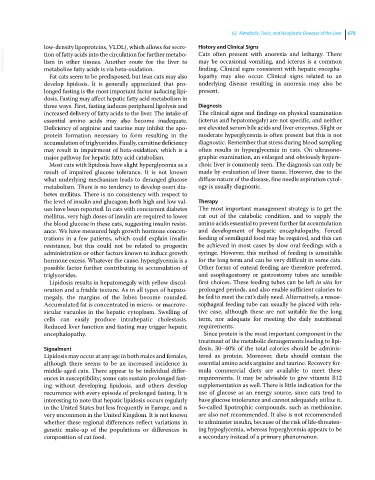Page 711 - Clinical Small Animal Internal Medicine
P. 711
62 Metabolic, Toxic, and Neoplastic Diseases of the Liver 679
low‐density lipoproteins, VLDL), which allows for secre- History and Clinical Signs
VetBooks.ir tion of fatty acids into the circulation for further metabo- may be occasional vomiting, and icterus is a common
Cats often present with anorexia and lethargy. There
lism in other tissues. Another route for the liver to
finding. Clinical signs consistent with hepatic encepha-
metabolize fatty acids is via beta‐oxidation.
Fat cats seem to be predisposed, but lean cats may also lopathy may also occur. Clinical signs related to an
develop lipidosis. It is generally appreciated that pro- underlying disease resulting in anorexia may also be
longed fasting is the most important factor inducing lipi- present.
dosis. Fasting may affect hepatic fatty acid metabolism in
three ways. First, fasting induces peripheral lipolysis and Diagnosis
increased delivery of fatty acids to the liver. The intake of The clinical signs and findings on physical examination
essential amino acids may also become inadequate. (icterus and hepatomegaly) are not specific, and neither
Deficiency of arginine and taurine may inhibit the apo- are elevated serum bile acids and liver enzymes. Slight or
protein formation necessary to form resulting in the moderate hyperglycemia is often present but this is not
accumulation of triglycerides. Finally, carnitine deficiency diagnostic. Remember that stress during blood sampling
may result in impairment of beta‐oxidation, which is a often results in hyperglycemia in cats. On ultrasono-
major pathway for hepatic fatty acid catabolism. graphic examination, an enlarged and obviously hypere-
Most cats with lipidosis have slight hyperglycemia as a choic liver is commonly seen. The diagnosis can only be
result of impaired glucose tolerance. It is not known made by evaluation of liver tissue. However, due to the
what underlying mechanism leads to deranged glucose diffuse nature of the disease, fine needle aspiration cytol-
metabolism. There is no tendency to develop overt dia- ogy is usually diagnostic.
betes mellitus. There is no consistency with respect to
the level of insulin and glucagon; both high and low val- Therapy
ues have been reported. In cats with concurrent diabetes The most important management strategy is to get the
mellitus, very high doses of insulin are required to lower cat out of the catabolic condition, and to supply the
the blood glucose in these cats, suggesting insulin resist- amino acids essential to prevent further fat accumulation
ance. We have measured high growth hormone concen- and development of hepatic encephalopathy. Forced
trations in a few patients, which could explain insulin feeding of semiliquid food may be required, and this can
resistance, but this could not be related to progestin be achieved in most cases by slow oral feedings with a
administration or other factors known to induce growth syringe. However, this method of feeding is unsuitable
hormone excess. Whatever the cause, hyperglycemia is a for the long term and can be very difficult in some cats.
possible factor further contributing to accumulation of Other forms of enteral feeding are therefore preferred,
triglycerides. and esophagostomy or gastrostomy tubes are sensible
Lipidosis results in hepatomegaly with yellow discol- first choices. These feeding tubes can be left in situ for
oration and a friable texture. As in all types of hepato- prolonged periods, and also enable sufficient calories to
megaly, the margins of the lobes become rounded. be fed to meet the cat’s daily need. Alternatively, a nasoe-
Accumulated fat is concentrated in micro‐ or macrove- sophageal feeding tube can usually be placed with rela-
sicular vacuoles in the hepatic cytoplasm. Swelling of tive ease, although these are not suitable for the long
cells can easily produce intrahepatic cholestasis. term, nor adequate for meeting the daily nutritional
Reduced liver function and fasting may trigger hepatic requirements.
encephalopathy. Since protein is the most important component in the
treatment of the metabolic derangements leading to lipi-
Signalment dosis, 30–40% of the total calories should be adminis-
Lipidosis may occur at any age in both males and females, tered as protein. Moreover, diets should contain the
although there seems to be an increased incidence in essential amino acids arginine and taurine. Recovery for-
middle‐aged cats. There appear to be individual differ- mula commercial diets are available to meet these
ences in susceptibility; some cats sustain prolonged fast- requirements. It may be advisable to give vitamin B12
ing without developing lipidosis, and others develop supplementation as well. There is little indication for the
recurrence with every episode of prolonged fasting. It is use of glucose as an energy source, since cats tend to
interesting to note that hepatic lipidosis occurs regularly have glucose intolerance and cannot adequately utilize it.
in the United States but less frequently in Europe, and is So‐called lipotrophic compounds, such as methionine,
very uncommon in the United Kingdom. It is not known are also not recommended. It also is not recommended
whether these regional differences reflect variations in to administer insulin, because of the risk of life‐threaten-
genetic make‐up of the populations or differences in ing hypoglycemia, whereas hyperglycemia appears to be
composition of cat food. a secondary instead of a primary phenomenon.

